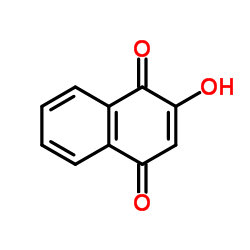2-Hydroxy-1,4-naphoquinone

2-Hydroxy-1,4-naphoquinone structure
|
Common Name | 2-Hydroxy-1,4-naphoquinone | ||
|---|---|---|---|---|
| CAS Number | 83-72-7 | Molecular Weight | 174.153 | |
| Density | 1.5±0.1 g/cm3 | Boiling Point | 339.9±42.0 °C at 760 mmHg | |
| Molecular Formula | C10H6O3 | Melting Point | 192-195 °C (dec.)(lit.) | |
| MSDS | Chinese USA | Flash Point | 173.6±24.4 °C | |
| Symbol |

GHS07 |
Signal Word | Warning | |
|
Sensitive electrochemical detection of Salmonella with chitosan-gold nanoparticles composite film.
Talanta 140 , 122-7, (2015) An ultrasensitive electrochemical immunosensor for detection of Salmonella has been developed based on using high density gold nanoparticles (GNPs) well dispersed in chitosan hydrogel and modified glassy carbon electrode. The composite film has been oxidized ... |
|
|
Allergic contact dermatitis caused by mehindi: a further case.
G. Ital. Dermatol. Venereol. 148(2) , 234-5, (2013)
|
|
|
Irritant contact dermatitis from a black henna tattoo without sensitization to para-phenylendiamine.
Pediatrics 131(6) , e1974-6, (2013) Allergic contact dermatitis from nonpermanent black henna tattoos has been frequently reported, particularly in children. Contamination or adulteration of the dyes with para-phenylendiamine has been identified as major cause of active sensitization and elicit... |
|
|
Protective effect of lawsone on L-Arginine induced acute pancreatitis in rats.
Indian J. Exp. Biol. 51(3) , 256-61, (2013) The efficacy of lawsone against L-arginine induced acute pancreatitis was determined at 24 h by determination of serum levels of amylase, lipase and proinflammatory cytokines [tumor necrosis factor (TNF)-alpha, C-reactive proteins and interleukin (IL)], pancr... |
|
|
Latent fingermark development on a range of porous substrates using ninhydrin analogs--a comparison with ninhydrin and 1,8-diazofluoren.
J. Forensic Sci. 57(2) , 509-14, (2012) Three relatively new reagents for developing latent fingermarks on porous substrates, 1,2-indandione (IND), 5-methylthioninhydrin (5-MTN), and lawsone, are compared with the more widely used ninhydrin and 1,8-diazofluoren (DFO). Developed latent fingermark vi... |
|
|
Plumbagin, a naphthaquinone derivative induces apoptosis in BRCA 1/2 defective castrate resistant prostate cancer cells as well as prostate cancer stem-like cells.
Pharmacol. Res. 105 , 134-45, (2016) Eventhough the role of BRCA1/2 in hereditary prostatic cancer is being unleashed at a rapid rate; their optimal clinical management remains undefined. Cancer stem cells are thought to be responsible for cancer chemoresistance and relapse, thus they represent ... |
|
|
Age-related sensitization to p-phenylenediamine.
Contact Dermatitis 64(3) , 172-4, (2011)
|
|
|
Unexpected one-pot synthesis of highly conjugated pentacyclic diquinoid compounds.
J. Org. Chem. 77(16) , 6873-9, (2012) A new class of pentacyclic diquinoid compounds has been synthesized with a facile one-pot reaction of two molecules of 2-hydroxynaphthoquinone and 1-bromoalkanes in the presence of ferrocene. These molecules were isolated as enol tautomers that exhibit intram... |
|
|
Antifungal activity of the Algerian Lawsonia inermis (henna).
Pharm. Biol. 51(1) , 131-5, (2013) Lawsonia inermis Linn. (Lythraceae) or henna has been used since the earliest times as a medicine, preservative, and cosmetic. It has long been recommended in traditional medicine as an astringent, purgative, and abortifacient.Lawsone and six extracts of L. i... |
|
|
Contact dermatitis with severe scalp swelling and upper airway compromise due to black henna hair dye.
Pediatr. Emerg. Care 27(8) , 745-6, (2011) Temporary tattooing with black henna is known to cause contact dermatitis; however, this adverse effect is not considered to be life threatening. We report a female adolescent who used black henna as a hair dye and developed severe contact dermatitis with sca... |